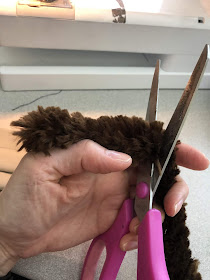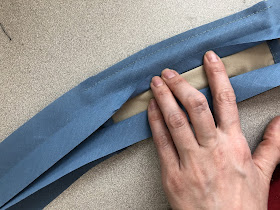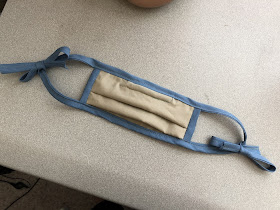I have really been inspired by rewatching the movie “Superman I.” (In fact, I wrote about it along with nine other ideas I bet you’ve never heard of on how to deal with this pandemic. You can read it here.) I have been trying to think of way to be a “Superman” during this pandemic, but it’s not easy!
My husband and I have really been trying to think of something we can do to help while maintaining good social distancing protocols. He suggested that we start calling everyone on our contact list to check in on them. I thought that was a great idea. It keeps infections from spreading, but it shows people you care.
I, on the other hand, had this really ambitious idea to make a ton of face masks. They don’t seem too hard to make, and I thought I could crank out 40-50 in a couple of hours.
Well, I was definitely wrong about my ambitions. It took me all day Saturday to crank out a paltry dozen. Like, literally all day!
Seriously, each one takes me about 30 minutes. And I work fast! It took at least an hour to cut all my fabric and then another six hours to make the twelve I made. So, I decided that since it’s not feasible for me to make masks for everyone I know and love. And since sitting at my machine for hours on end kills my back. And since I have to tear up my work-from-home office every time I want to get to my sewing machine, and then put it back together for work the next day. And especially when everyone else seems just to be reading books, watching movies, and “Netflix and Chill”-ing. And since people tend to ask me to make them things that they never end up using.
I thought: Why am I going to kill myself making a million masks???
I decided that we would distribute the ones I made among our neighbors. Besides, this cuts down on the social contact of driving around to deliver masks to everyone. And it creates a sense of community around your home.
If we all made masks or bought toilet paper or delivered groceries to the three to five people we live around, this whole pandemic would be a lot nicer and more manageable. Plus, this sort of help is a lot more sustainable versus trying to make a million masks for everyone you know!
Then, I decided I would write a mask tutorial for everyone else. You really need to learn how to sew, and you’ve got a ton of time on your hands if you’re not working. Here’s another reason it’s better for you to make your own masks: Liability. No one knows who has this CoVID-19 and who doesn’t. What happens if I make you a mask and then you get coronavirus from me? I’m not gonna play that game. Incidentally, if you are ordering a homemade mask from anyone, you need to make sure that you wash it and let it thoroughly dry before you wear it. However, if you make it yourself from your own fabric, you don’t have to worry about that at all!
So, I’m just going to warn you. This isn’t the easiest tutorial out there. I am just going to show you my process, in case you are interested. My method uses bias tape, because I wanted to use what I have already and I have a lot of bias tape. If you don’t know what bias tape is, then clearly, you need to look for a different tutorial. (Google: “Easy mask tutorial”) I will say that my version can be washed and tumble dried. (Although, line dry is better as tumble drying can strip the filtering of the fabric over time.)
On the bright side: Even if you are a terrible sewer and are really sloppy, that’s fine! These don’t have to be perfect. They just have to be functional, so give yourself some grace.
Here’s what I used: A Ralph Lauren bed sheet, white cotton, baby blanket flannel, chenille wire (pipe cleaners), and bias tape.
So I read from another tutorial that an 8”x8” square is good for adults and 7”x6” is good for children. I cut the fabric accordingly.
Originally, I made these three-ply—wanting to be as safe as possible. However, I think as long as you have a good quality cotton and a layer of flannel, you should be okay. All the sources I read said these were the best fabrics to use. You do have to actually breathe through them! So, maybe don’t make too many layers.
Note: When wearing face masks, you need to limit your movement. Because they constrict your air flow, you will get winded if you try to run or move too quickly with one on.
So fold the top down approximately 1 1/2” and pin it.
Make another fold and pin that too. I’m sorry. I don’t use exact measurements. I just eyeball it and make it look like this each time.
Then, I pinned some bias tape to the edge.
After I sewed that down, I folded the bias tape in half. (Most bias tape comes prefolded, so you probably won’t have to do this.)
Then, I folded the edge of the tape to the middle crease I’d just made.
Then, I flipped the bias tape around the mask’s edge and pinned it in place.
I stitched in the ditch, but you could also top stitch if you want. It doesn’t have to be perfect.
So this is what both edges looked like bound in the bias tape.
Now, I had to sew in a little pocket at the top to put in the chenille wire. (This is so you can adjust the mask over your nose.) Start the pocket about 1 1/2” from the side edge. Sew down about 3/4” and then across and back up. Look at the picture after this one to see what that looks like.
This is what the little pocket looks like when you are done.
Then, I measured how much chenille wire I needed against the pocket.
My chenille wire is really thick and fuzzy for some reason. Most pipe cleaners are a lot thinner. You probably will never have to do this step to cut it down. However, I wanted to use what I already had versus running to the store.
After trimming the wire, I folded the ends over to keep them from poking out of the mask.
Then, I placed the wire into the pocket.
Then, I stitched it in place. Again this doesn’t have to look nice. You just want a simple stitch to keep the wire from popping out.
Sorry that the picture is sideways, but you can see the wire is in place.
Next, I cut two approximately 22” piece of the bias tape. I didn’t formally measure these pieces. I just used my arm as a measurement.
Then, I folded both pieces in half and finger pressed a crease.
I matched the crease to the middle of the mask.
And then I pinned each piece—one to the top and one to the bottom of the mask.
After stitching them in place, I folded the bias tape in half lengthwise and finger pressed them.
Then, I folded the edges into the middle crease, beginning with the middle of the mask.
Then, I flipped it over the edge.
And I pinned it in place.
Then, I just worked my way from the middle out to the outer ends and pinned as I went.
This is the most difficult part, but once you get all your pins in, it’s straight shooting from here and you’re done!
The finished mask.
So I made the straps long so that they can be worn one of two ways.
This first way is tied around back.
But not all heads are created equal, and some people don’t like them tied behind their heads.
In that event, you can just tie the ties in loops like this and hang them off your ears. If you don’t like the bows, you can either make the straps shorter to begin with or you can cut them down once you get them how you want them.
Happy sewing!
The End!








































fm disposable mask for kids
ReplyDeletefm disposable medical facemask
ReplyDelete